Flower Tourism, an enchanting blend of travel and horticulture, offers unforgettable experiences amidst nature’s vibrant tapestry. Let SIXT.VN be your guide to Vietnam’s most captivating floral destinations, along with essential travel services for a seamless journey. Uncover hidden blooms and scenic landscapes, and experience colorful culture.
1. What is Flower Tourism and Why is it Gaining Popularity?
Flower tourism is a niche travel market where the primary motivation for travel is to experience the beauty and diversity of flowers in various locations, attracting travelers seeking unique natural and cultural experiences. According to a report by the World Tourism Organization (UNWTO), nature-based tourism, including flower tourism, is growing at three times the rate of general tourism. This rise is attributed to several factors:
- Increased Appreciation for Nature: People are increasingly seeking out experiences that connect them with nature.
- Visual Appeal: Flowers are inherently beautiful and provide stunning photo opportunities, driving interest through social media.
- Cultural Significance: Many flowers have deep cultural and historical significance, adding an educational element to the travel experience.
- Unique Experiences: Flower festivals, garden tours, and botanical expeditions offer unique and memorable experiences.
- Seasonal Travel: Flower blooms are seasonal, providing a reason to travel at specific times of the year, boosting local economies.
2. Where Can You Find Stunning Poppy Fields in California?
You can find stunning poppy fields in California at the Antelope Valley California Poppy Reserve during spring, where the high desert landscape transforms into a vibrant display of orange and yellow. Poppies are native to California, thriving particularly in the western Mojave Desert. The Antelope Valley California Poppy Reserve, managed by the California Department of Parks and Recreation, is the premier location for viewing these blooms.
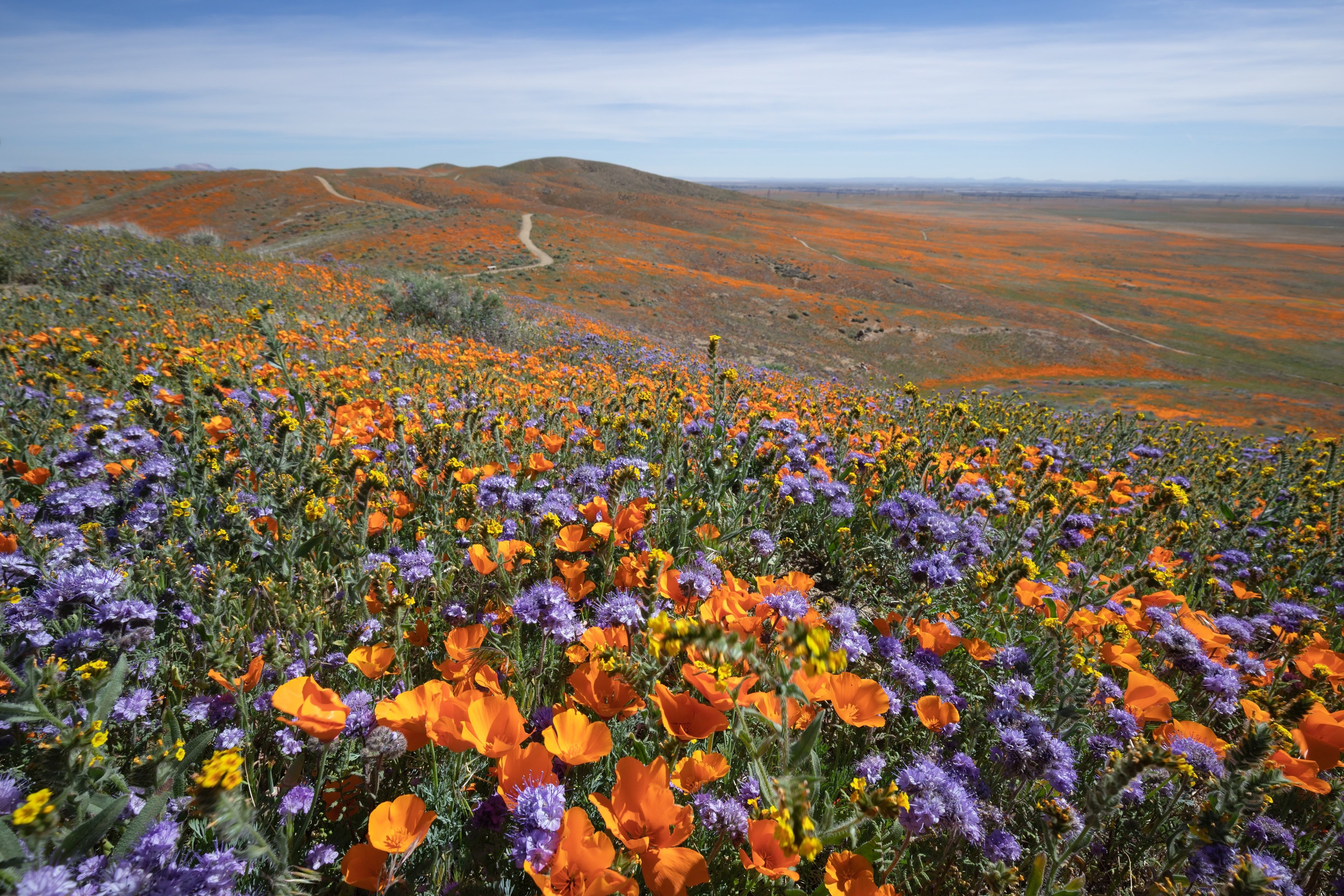 Antelope Valley California Poppy Reserve
Antelope Valley California Poppy Reserve
The peak bloom period typically occurs from March to May, depending on rainfall and weather conditions. The reserve features walking trails that allow visitors to immerse themselves in the vibrant landscape without disturbing the delicate flowers. The best time to visit is during the early morning or late afternoon when the light is soft, and the poppies are fully open.
3. Why is Cherry Blossom Season in Kyoto, Japan a Must-See?
Cherry blossom season in Kyoto, Japan, is a must-see because it offers a breathtaking display of delicate pink sakura blossoms, combined with the city’s rich cultural heritage and serene landscapes. The cherry blossoms, known as sakura, hold a special place in Japanese culture, symbolizing renewal, beauty, and the transient nature of life. The practice of hanami, or flower viewing, is a cherished tradition where people gather under the blooming trees to appreciate their beauty.
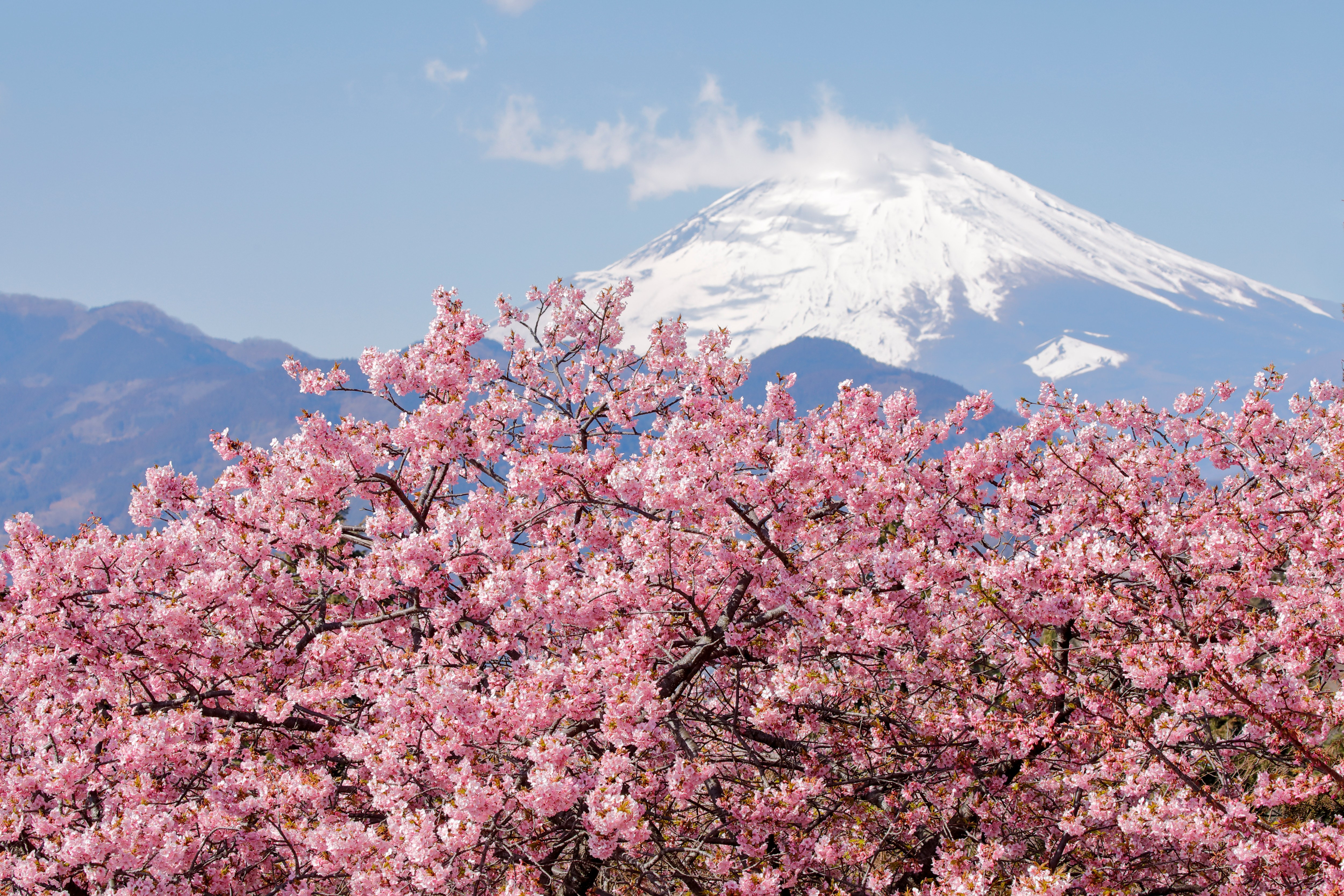 Kawadu cherry blossoms with Mount Fuji in the background
Kawadu cherry blossoms with Mount Fuji in the background
Kyoto, with its ancient temples, traditional gardens, and historic streets, provides an exquisite backdrop for the cherry blossoms. Key viewing spots include:
- Hirano Shrine: Known for its diverse varieties of cherry trees.
- Kamogawa Riverside: Offers picturesque views along the riverbanks.
- Ryoanji Temple: Features a famous rock garden complemented by cherry blossoms.
- Ninnaji Temple: Renowned for its late-blooming Omuro cherry trees.
The cherry blossom season typically occurs from late March to early April, drawing large crowds of both locals and tourists. It’s advisable to book accommodations and transportation well in advance. Visitors can enhance their experience by participating in traditional tea ceremonies, wearing kimono, and enjoying local cuisine that incorporates seasonal ingredients.
4. When is the Best Time to Visit Tulip Fields in the Netherlands?
The best time to visit tulip fields in the Netherlands is from late March to mid-May, with the peak bloom usually occurring in mid-April, offering a spectacular display of vibrant colors. During this period, the tulip fields across the Dutch countryside burst into a riot of hues, creating stunning landscapes that attract visitors from around the world.
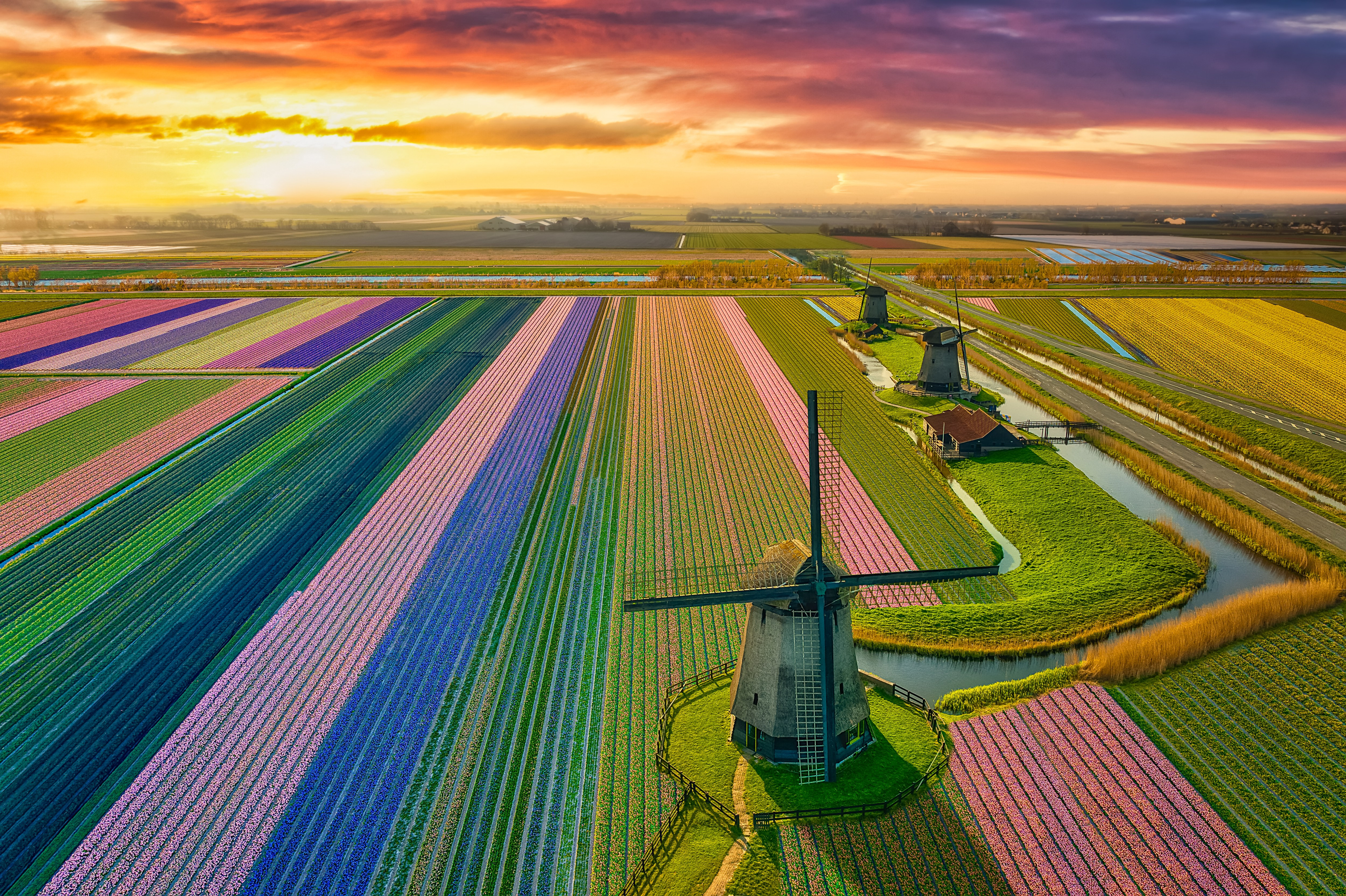 Tulip fields blooming during springtime at sunrise in the Netherlands
Tulip fields blooming during springtime at sunrise in the Netherlands
Key locations for experiencing the tulip season include:
- Keukenhof Gardens: One of the world’s largest flower gardens, showcasing millions of tulips, daffodils, and hyacinths.
- Lisse: A town surrounded by vast tulip fields, offering bike tours and walking paths to explore the blooms up close.
- Aalsmeer Flower Auction: The largest flower auction in the world, providing a behind-the-scenes look at the flower industry.
- Pronk Tulip Farm in Avenhorn: Buy various bulbs.
Visiting during the peak bloom ensures the most vibrant and complete display of tulips. It is recommended to check the annual bloom forecast to plan the trip accordingly.
5. What Makes the Rose Gardens in Rome Special?
The rose gardens in Rome are special because they combine the timeless beauty of roses with the historical and cultural richness of the city, offering a unique and enchanting experience. Rome is surrounded by extraordinary gardens, with the Garden of Ninfa in Lazio standing out as a prime example. This romantic English-style garden, founded in 1920 among the ruins of an ancient temple and medieval town, features over 1,300 botanical species, including roses that ramble over the old stone and along the river in early summer.
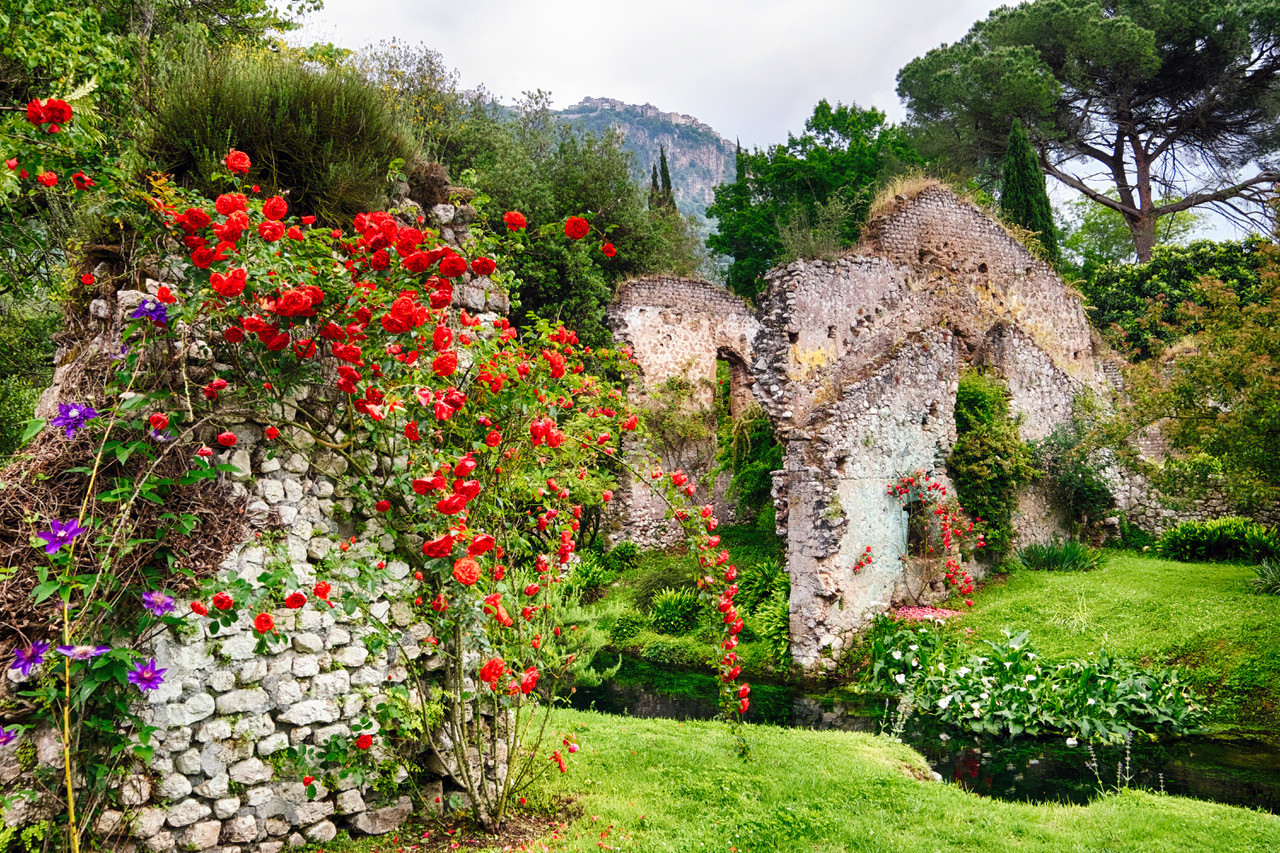 The Garden of Ninfa in Lazio
The Garden of Ninfa in Lazio
Key features that make Rome’s rose gardens special:
- Historical Setting: The gardens are often located near ancient ruins and historical sites, providing a unique backdrop.
- Botanical Diversity: The gardens showcase a wide variety of rose species, from ancient varieties to modern hybrids.
- Romantic Atmosphere: The combination of roses, ruins, and Italian architecture creates a romantic and picturesque setting.
- Cultural Significance: Roses have been a symbol of love and beauty in Roman culture for centuries.
The best time to visit Rome’s rose gardens is in May, when the roses are in full bloom.
6. Why are Hydrangeas So Abundant in the Azores?
Hydrangeas are abundant in the Azores due to the islands’ mild climate, plentiful rainfall, and the acidity of the volcanic soil, creating ideal conditions for their growth. While hydrangeas are not native to this Portuguese archipelago in the Atlantic, they have thrived since being introduced, likely from Japan.
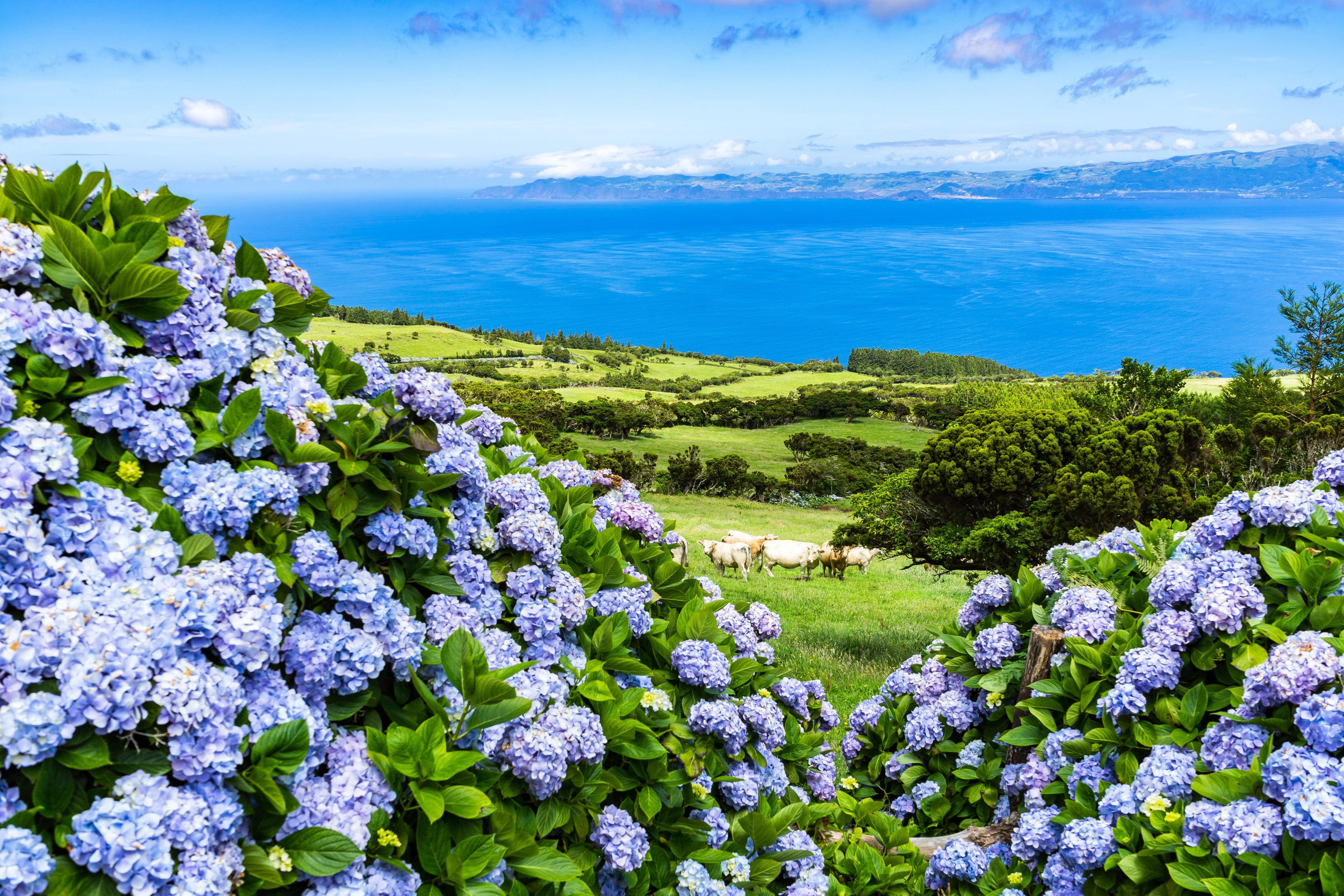 Pico Island in the Azores
Pico Island in the Azores
Factors contributing to the abundance of hydrangeas:
- Mild Climate: The Azores have a temperate climate with consistent temperatures, promoting year-round growth.
- High Rainfall: The islands receive abundant rainfall, providing the necessary moisture for hydrangeas to flourish.
- Acidic Soil: The volcanic soil is naturally acidic, which hydrangeas prefer.
- Lack of Natural Predators: The absence of significant natural predators allows hydrangeas to spread and thrive.
The island of Faial is particularly known for its hydrangeas, where the acidic soil turns the flowers a beautiful deep blue. Hydrangeas can be found on all nine islands of the Azores, blooming from May to September.
7. When is Lavender Season in the Luberon, Provence?
Lavender season in the Luberon, Provence, is from June to August, offering a sensory-rich experience as the fields burst into a sea of purple, filling the air with their distinctive fragrance. During this period, the lavender fields reach their peak bloom, creating stunning landscapes that attract visitors from around the world.
 A lavender field near Valensole in Provence
A lavender field near Valensole in Provence
Key locations for experiencing the lavender season:
- Valensole Plateau: Known for its vast and iconic lavender fields.
- Abbey of Notre-Dame de Sénanque: A historic abbey surrounded by lavender fields, where monks sell lavender products.
- Musée de la Lavande: A museum dedicated to the history and cultivation of lavender.
The best time to visit for the most vibrant blooms is typically in July. Visitors can enjoy cycling tours, scenic drives, and the opportunity to purchase lavender products directly from local producers.
8. Why Should You Visit Daisies in South Africa’s Northern Cape?
You should visit daisies in South Africa’s Northern Cape because the region transforms into a vibrant tapestry of wildflowers during August and September, showcasing a unique biodiversity hotspot. The Western and Northern Cape are often overlooked in favor of the Winelands, the Garden Route, and the safari lodges and camps of the east but, for flower buffs, there’s no contest.
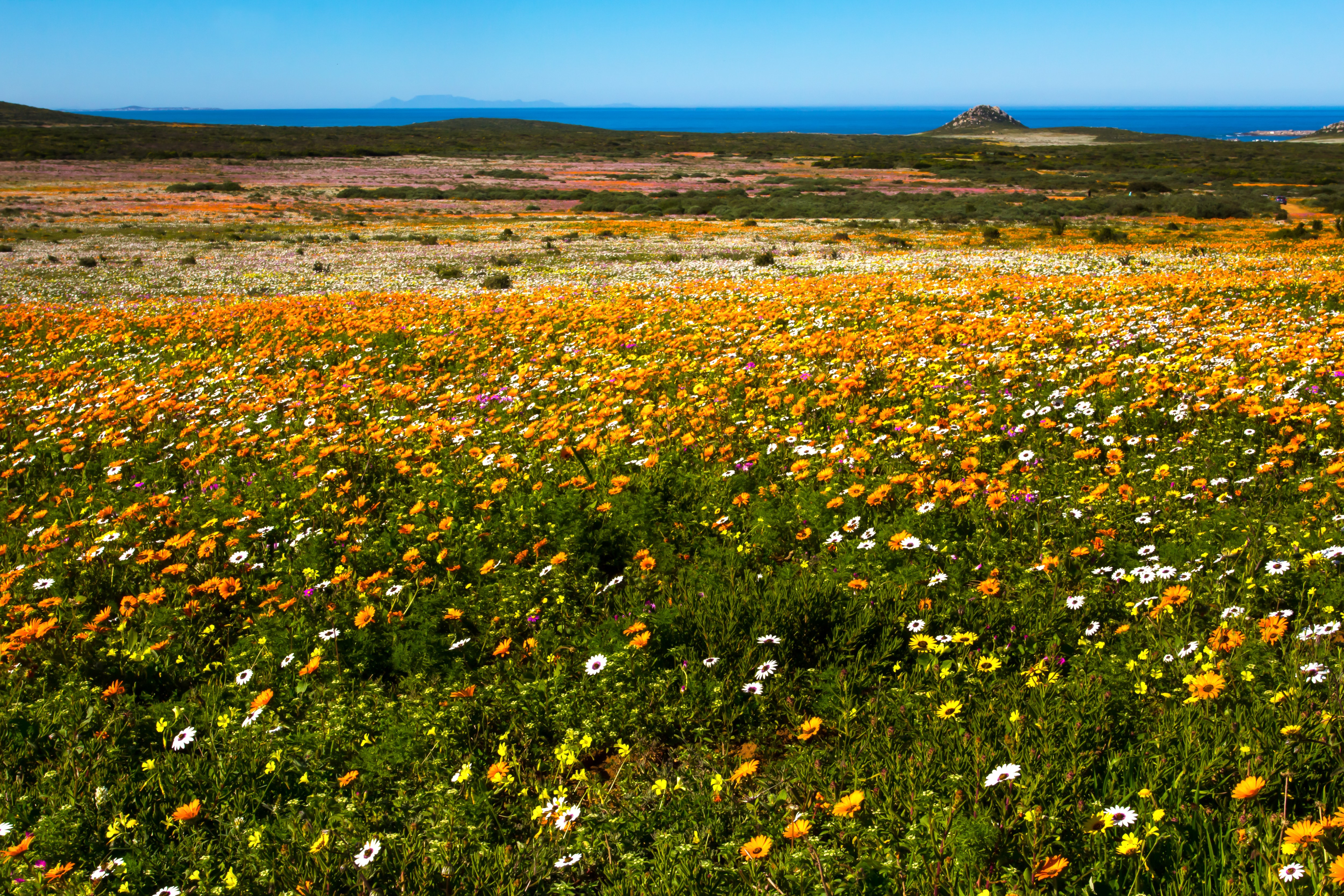 The West Coast National Park
The West Coast National Park
Reasons to visit:
- Biodiversity Hotspots: The region includes the Fynbos shrubland, part of the Cape Floral Kingdom, with nearly 6,000 endemic species, including the Clanwilliam daisy, and the Succulent Karoo, with over 2,000 endemic species.
- Namaqualand Daisies: The orange Namaqualand daisies create a spectacular display.
- Unique Flora: Visitors can see a variety of unique flowers, including purple morning glories and other endemic species.
The drive north from Cape Town offers stunning views and the opportunity to explore the region’s diverse landscapes. This area is a must-see for any flower enthusiast.
9. When is the Best Time to See Orchids in Western Australia?
The best time to see orchids in Western Australia is from September to October, when the region’s diverse wildflowers, including numerous orchid species, are in full bloom. The largest state in Australia also has the country’s biggest collection of wildflowers, which ripple across the Pilbara and Goldfields and down the Coral coast to Perth and Margaret River between June and October.
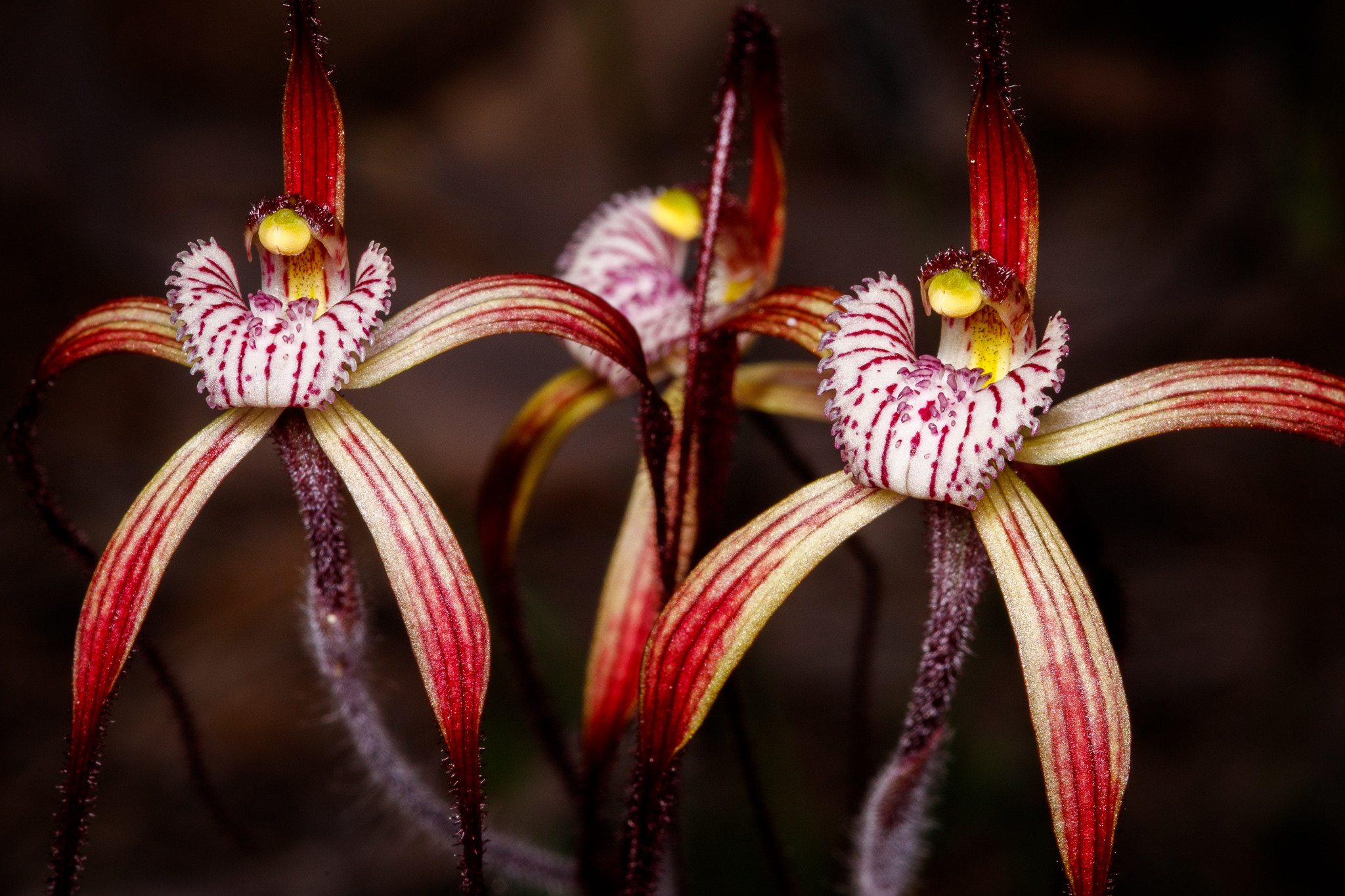 The Chapman’s spider orchid
The Chapman’s spider orchid
Key areas for orchid viewing:
- Southwest Region: Part of a global biodiversity hotspot, offering a profusion of wildflowers, including Chapman’s spider and bright-yellow donkey orchids.
- Pilbara and Goldfields: Known for their vast landscapes covered in wildflowers.
- Coral Coast: Provides a scenic backdrop for wildflower viewing.
Guided treks along the Cape to Cape Track offer opportunities to see orchids and other wildflowers up close. The combination of natural beauty and unique floral displays makes Western Australia a prime destination for flower tourism.
10. Where Can You Find Passion Flowers in Brazil and When Should You Go?
You can find passion flowers in Brazil, particularly in the Mato Grosso reserve, and the best time to see them is in July and August. Passiflora cristalina — a variety of the passion flower — was unknown to scientists until 2009, when it was one of five species discovered by scientists from the Royal Botanic Gardens in Kew, the University of São Paulo and the Cristalino Foundation.
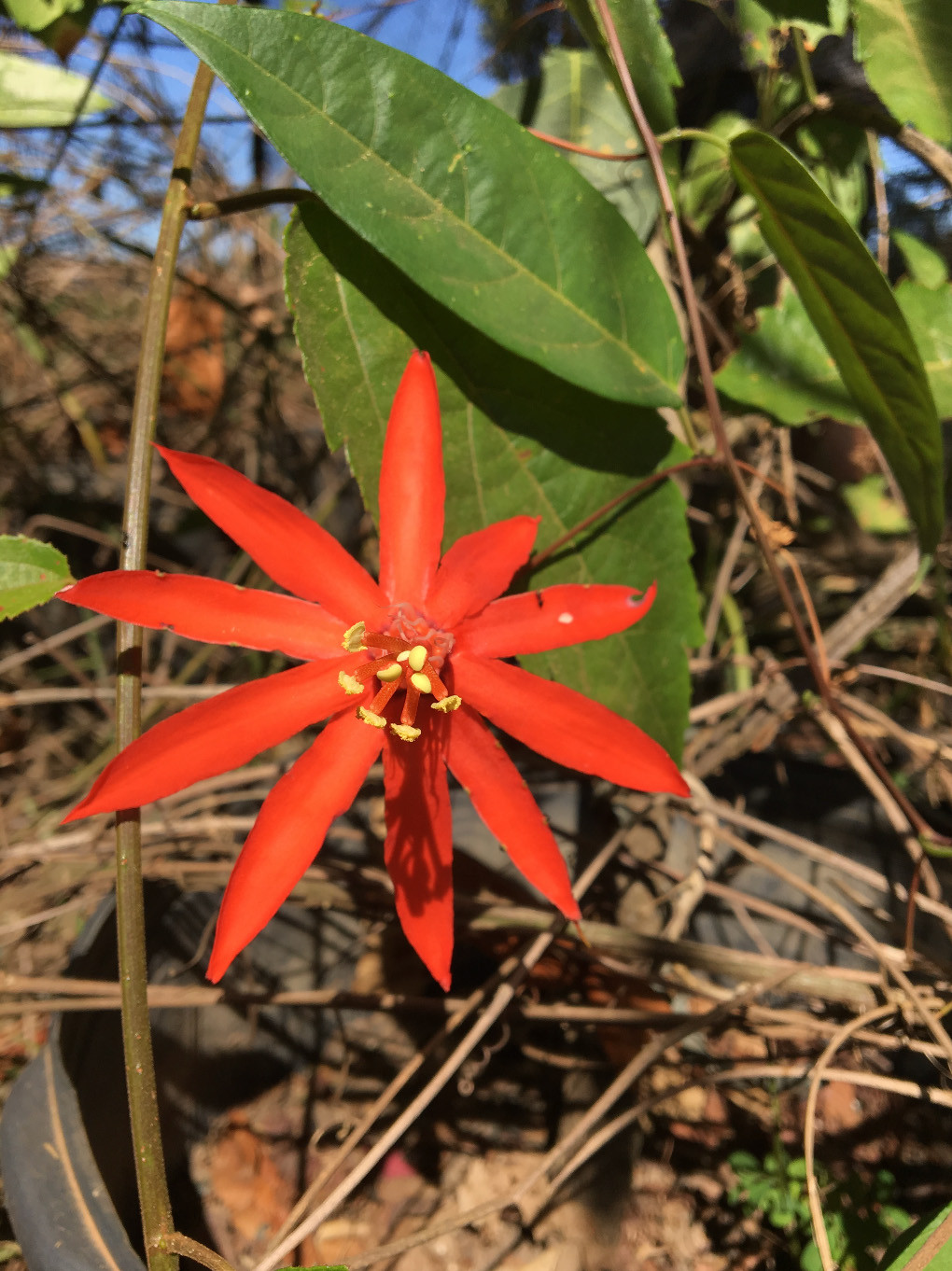 Passiflora Cristalina, a red-flowered species of passion flower
Passiflora Cristalina, a red-flowered species of passion flower
The Rio Cristalino area, where Passiflora cristalina was discovered, is a prime location for seeing these flowers. The reserve, covering 28,200 acres, faces threats from forest clearance, making it a critical area for conservation.
Staying at Cristalino Lodge provides access to the forest canopy, where passion flowers thrive. Climbing the observation towers offers a unique perspective on the forest and its floral diversity.
11. When is the Best Time to See Almond Blossom in Spain?
The best time to see almond blossom in Spain is in February, when the rural region of Matarraña transforms into a pristine paradise awash with pale-pink, honey-scented almond blossoms. Matarraña, located halfway between Barcelona and Valencia, has been dubbed the Tuscany of Spain.
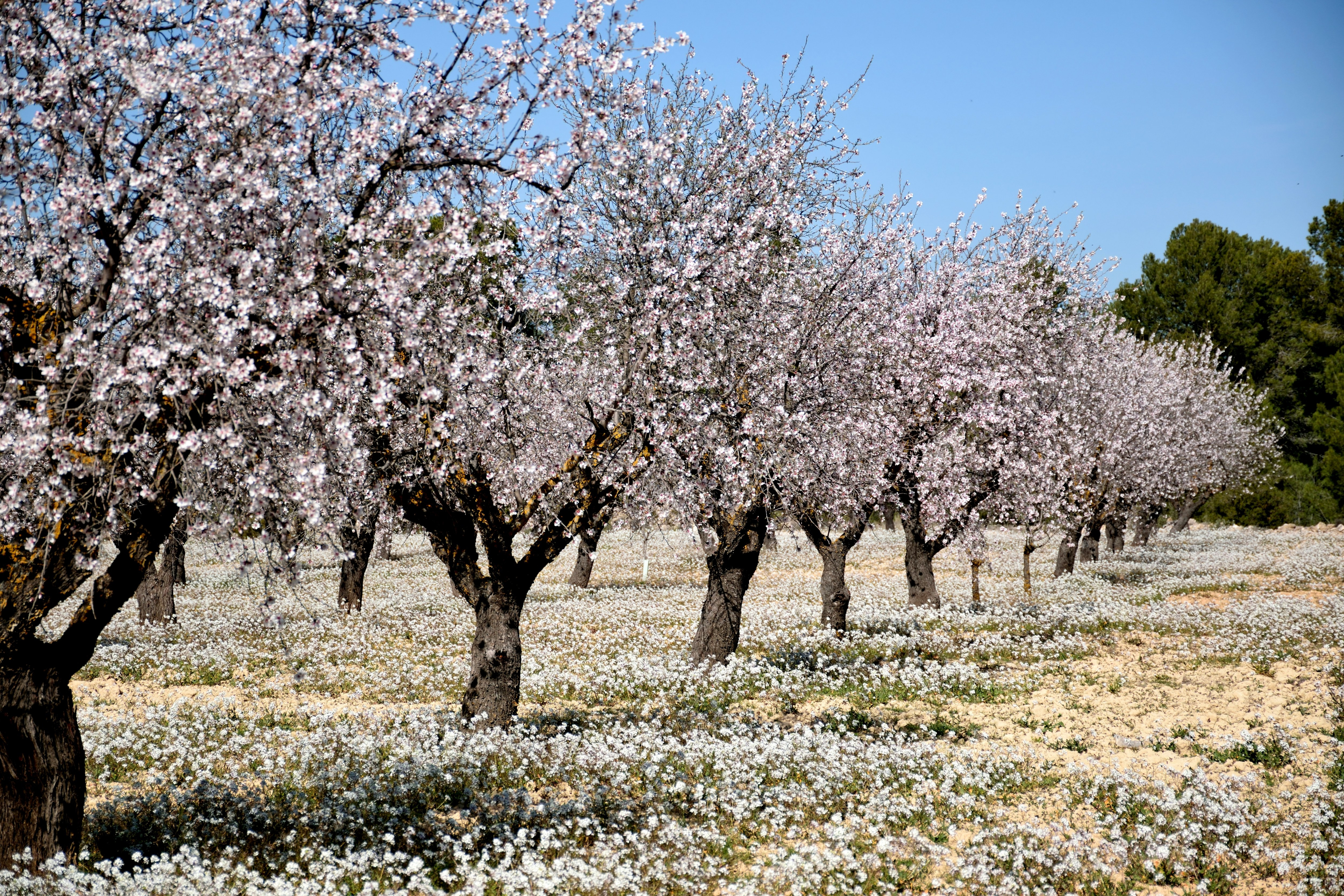 Almond trees in Villalpardo
Almond trees in Villalpardo
Key highlights of visiting during almond blossom season:
- Pale-Pink Blossoms: The landscape is covered in delicate, pale-pink almond blossoms.
- Honey Scent: The air is filled with the sweet scent of honey from the blossoms.
- Rural Scenery: The pristine, rural region offers a peaceful and scenic experience.
- Poppy Fields: Late April to early May brings a sea of red poppies, providing a second floral display.
Staying at La Torre del Visco, a medieval tower house, offers a tranquil base for exploring the almond groves and surrounding area. Wandering through the olive and almond groves to the river and savoring the local wine enhances the experience.
12. How Can SIXT.VN Enhance Your Flower Tourism Experience in Vietnam?
SIXT.VN can significantly enhance your flower tourism experience in Vietnam by providing a range of convenient and reliable services tailored to your travel needs. Understanding the challenges international travelers face, SIXT.VN offers solutions to make your journey seamless and enjoyable.
12.1. Tailored Travel Itineraries
SIXT.VN provides personalized travel itineraries that align with your interests and schedule. Whether you are a solo traveler, a couple, a family, or a group of friends, we can craft an itinerary that showcases Vietnam’s most beautiful floral destinations. According to the Vietnam National Administration of Tourism, customized tours are increasingly popular among international visitors seeking unique experiences.
- Personalized Recommendations: We suggest destinations based on your preferences, such as the best time to see cherry blossoms in Sapa or lotus flowers in the Mekong Delta.
- Flexible Scheduling: We adapt the itinerary to your time frame, ensuring you see the most stunning blooms without rushing.
12.2. Airport Transfer Services
Arriving in a new country can be stressful, but SIXT.VN offers reliable and comfortable airport transfer services to ease your arrival. Our professional drivers ensure you reach your hotel safely and efficiently.
- Hassle-Free Arrival: Our drivers will meet you at the airport and assist with your luggage.
- Comfortable Transportation: We provide a range of vehicles to suit your needs, from sedans to vans.
12.3. Hotel Booking Assistance
Finding the right accommodation is crucial for a comfortable trip. SIXT.VN offers assistance in booking hotels that suit your budget and location preferences.
- Wide Range of Options: We provide a variety of hotels, from budget-friendly to luxury accommodations.
- Strategic Locations: We recommend hotels that are conveniently located near flower viewing spots and other attractions.
12.4. Tour and Ticket Booking
SIXT.VN simplifies the process of booking tours and tickets to popular attractions. We offer a curated selection of tours that highlight Vietnam’s floral beauty and cultural landmarks.
- Guided Tours: Our knowledgeable guides provide insights into the local flora and culture.
- Skip-the-Line Tickets: We help you avoid long queues, maximizing your time at each destination.
12.5. Flight Booking Services
Finding affordable and convenient flights is essential for international travel. SIXT.VN offers flight booking services to help you find the best deals and schedules.
- Competitive Prices: We search for the most competitive flight prices to fit your budget.
- Flexible Options: We offer a range of flight options to suit your travel dates and preferences.
12.6. Professional Tour Services in Hanoi
SIXT.VN offers professional tour services in Hanoi, ensuring you experience the city’s floral beauty and cultural richness with ease and comfort. Hanoi, with its blend of historical charm and modern vibrancy, serves as an excellent base for exploring flower tourism in Vietnam.
- Expert Local Guides: Our tours are led by knowledgeable local guides who provide in-depth insights into Hanoi’s history, culture, and floral significance. They can take you to hidden gems and share stories that bring the city to life.
- Customizable Itineraries: Whether you’re interested in ancient temples, bustling markets, or serene gardens, our itineraries can be tailored to your specific interests.
- Comfortable Transportation: Travel around Hanoi in comfort with our reliable transportation options, including private cars and vans, ensuring a relaxed and enjoyable experience.
12.7. Addressing Customer Challenges
- Planning Complexity: We simplify the planning process with personalized itineraries and booking assistance.
- Language and Cultural Barriers: Our bilingual guides and support staff help bridge communication gaps.
- Service Reliability: We ensure reliable and high-quality services through trusted partnerships.
- Navigation Difficulties: We provide transportation and guidance to help you navigate unfamiliar locations.
By addressing these challenges, SIXT.VN ensures that your flower tourism experience in Vietnam is seamless, enjoyable, and memorable.
13. What Unique Floral Destinations Can You Explore with SIXT.VN in Vietnam?
With SIXT.VN, you can explore a variety of unique floral destinations in Vietnam, each offering its own distinct charm and beauty. Vietnam’s diverse climate and geography support a wide range of floral species, making it a paradise for flower enthusiasts.
13.1. Hanoi Flower Market
The Hanoi Flower Market, also known as Quang Ba Flower Market, is a vibrant hub of floral activity, offering a sensory feast of colors and fragrances. Open primarily at night, this bustling market is where local florists and vendors gather to buy and sell a wide variety of flowers, from traditional Vietnamese blooms to imported species.
- Variety of Flowers: Explore an extensive selection of fresh flowers, including roses, lilies, orchids, and seasonal specialties.
- Cultural Experience: Immerse yourself in the local culture as you witness the bustling trade and interactions between vendors and buyers.
- Photography Opportunities: Capture stunning photos of the vibrant displays and lively atmosphere.
13.2. Sapa’s Cherry Blossoms
During the spring, Sapa transforms into a pink paradise with its blooming cherry blossoms. The cool climate and mountainous terrain provide the perfect conditions for these delicate flowers to thrive, creating picturesque landscapes that attract visitors from far and wide.
- Scenic Beauty: Enjoy breathtaking views of cherry blossoms set against the backdrop of Sapa’s rolling hills and rice terraces.
- Cultural Integration: Combine your floral adventure with visits to local ethnic villages, experiencing the unique culture and hospitality of the Hmong and Dao communities.
- Hiking Opportunities: Explore the region’s scenic trails, discovering hidden groves of cherry blossoms along the way.
13.3. Da Lat’s Flower Gardens
Da Lat, known as the “City of Flowers,” is home to numerous flower gardens that showcase a stunning array of blooms. The city’s temperate climate and fertile soil make it an ideal location for cultivating a wide variety of flowers, from roses and orchids to hydrangeas and sunflowers.
- Da Lat Flower Garden: Visit the iconic Da Lat Flower Garden, featuring meticulously manicured displays of colorful flowers.
- Hydrangea Fields: Explore the vast fields of hydrangeas, creating a sea of blue, pink, and purple hues.
- Valley of Love: Discover the romantic Valley of Love, adorned with flower sculptures and scenic viewpoints.
13.4. Mekong Delta’s Lotus Fields
The Mekong Delta is renowned for its expansive lotus fields, which bloom in the summer months, creating a serene and picturesque landscape. The lotus flower holds deep cultural significance in Vietnam, symbolizing purity, enlightenment, and rebirth.
- Boat Tours: Take a boat tour through the lotus fields, enjoying the tranquil atmosphere and stunning scenery.
- Cultural Immersion: Visit local villages and learn about the traditional uses of lotus flowers in Vietnamese cuisine and medicine.
- Photography Opportunities: Capture stunning photos of the lotus flowers floating on the water, creating a sense of peace and tranquility.
13.5. Moc Chau’s White Mustard Flowers
In the late autumn and early winter, Moc Chau is covered in a blanket of white mustard flowers, creating a breathtaking sight. The rolling hills and valleys of Moc Chau provide the perfect canvas for these delicate flowers to bloom, attracting visitors seeking a unique floral experience.
- Scenic Landscapes: Enjoy panoramic views of the white mustard flower fields stretching as far as the eye can see.
- Cultural Experiences: Visit local tea plantations and learn about the tea-making process.
- Photography Opportunities: Capture stunning photos of the white mustard flowers against the backdrop of Moc Chau’s misty mountains.
These destinations offer a glimpse into the diverse floral beauty of Vietnam, each providing a unique and memorable experience.
14. What are the Steps to Book Your Flower Tourism Trip with SIXT.VN?
Booking your flower tourism trip with SIXT.VN is a straightforward and user-friendly process designed to ensure a seamless and enjoyable experience.
14.1. Visit the SIXT.VN Website
- Navigate to the Website: Open your web browser and go to the SIXT.VN homepage.
- Explore Services: Take a moment to explore the range of services offered, including tour packages, airport transfers, hotel bookings, and flight bookings.
14.2. Select Your Desired Services
- Choose Tour Package: Select one of our pre-designed flower tourism packages or opt for a custom itinerary.
- Customize Your Trip: Provide details about your preferences, such as destinations, duration, and activities.
- Add Additional Services: Include airport transfers, hotel bookings, and flight arrangements to complete your travel plan.
14.3. Provide Your Information
- Personal Details: Enter your personal information, including your name, contact details, and passport information.
- Travel Dates: Specify your travel dates to ensure accurate booking and availability.
- Special Requests: Add any special requests, such as dietary restrictions or accessibility needs.
14.4. Review Your Booking
- Check Details: Carefully review all the details of your booking, including dates, destinations, and services.
- Verify Information: Ensure all information is accurate to avoid any issues during your trip.
14.5. Make Payment
- Select Payment Method: Choose your preferred payment method, such as credit card, debit card, or bank transfer.
- Secure Payment: Enter your payment details through our secure payment gateway.
- Confirmation: Receive a booking confirmation email with all the details of your trip.
14.6. Prepare for Your Trip
- Visa Requirements: Check visa requirements for Vietnam and apply for a visa if necessary.
- Travel Documents: Gather all necessary travel documents, including your passport, visa, booking confirmation, and itinerary.
- Pack Appropriately: Pack clothing and accessories suitable for the climate and activities you have planned.
By following these simple steps, you can easily book your flower tourism trip with SIXT.VN and look forward to an unforgettable experience in Vietnam.
15. What are the E-E-A-T and YMYL Considerations for Flower Tourism Content?
Ensuring high-quality content for flower tourism requires adherence to E-E-A-T (Experience, Expertise, Authoritativeness, and Trustworthiness) and YMYL (Your Money or Your Life) principles. These guidelines are crucial for providing accurate, reliable, and safe information to users.
15.1. E-E-A-T Considerations
- Experience:
- Firsthand Knowledge: Share firsthand experiences and insights from visiting flower tourism destinations.
- Personal Anecdotes: Include personal stories and anecdotes to add authenticity and credibility.
- Expertise:
- Qualified Information: Provide information from knowledgeable sources.
- Accuracy: Ensure all floral, geographical, and cultural facts are accurate and up-to-date.
- Authoritativeness:
- Credible Sources: Cite credible sources such as tourism boards, botanical gardens, and academic research.
- Industry Recognition: Highlight any recognition or awards received by destinations or tour operators.
- Trustworthiness:
- Transparent Information: Provide transparent and honest information about destinations, including both pros and cons.
- User Reviews: Include user reviews and testimonials to provide a balanced perspective.
15.2. YMYL Considerations
- Safety Information:
- Travel Advisories: Include relevant travel advisories and safety tips for each destination.
- Health Recommendations: Provide health recommendations, such as vaccinations and precautions against local diseases.
- Financial Security:
- Secure Booking: Ensure secure booking and payment processes for tours, accommodations, and flights.
- Clear Pricing: Provide clear and transparent pricing information, avoiding hidden fees.
- Cultural Sensitivity:
- Respectful Content: Create content that is respectful of local cultures and traditions.
- Ethical Tourism: Promote ethical tourism practices, such as supporting local businesses and minimizing environmental impact.
By adhering to these E-E-A-T and YMYL principles, SIXT.VN ensures that our flower tourism content is not only informative and engaging but also trustworthy and safe for our users.
16. How Can SIXT.VN Help with Visa and Travel Requirements for Vietnam?
SIXT.VN offers comprehensive support for navigating visa and travel requirements for Vietnam, ensuring a smooth and stress-free journey for international visitors. Understanding the complexities of international travel, we provide guidance and assistance to help you meet all necessary requirements.
16.1. Visa Guidance
- Information on Visa Types: Provide detailed information on the different types of visas available for Vietnam, including tourist visas, business visas, and student visas.
- Eligibility Criteria: Clearly outline the eligibility criteria for each visa type, helping you determine which visa is most appropriate for your travel purpose.
- Application Process: Offer step-by-step guidance on the visa application process, including required documents, application forms, and submission procedures.
- Updates on Visa Policies: Keep you informed about any changes or updates to Vietnam’s visa policies, ensuring you have the most current information.
16.2. Documentation Assistance
- Passport Requirements: Advise on passport validity requirements, ensuring your passport is valid for at least six months beyond your intended stay in Vietnam.
- Required Documents: Provide a checklist of all necessary documents for your visa application and travel, such as passport copies, photographs, and travel itinerary.
- Document Verification: Offer a document verification service to review your documents and ensure they meet the requirements of the Vietnamese government.
16.3. Travel Regulations
- Customs Regulations: Provide information on customs regulations, including restrictions on importing certain items and guidelines for declaring goods.
- Health Regulations: Advise on health regulations, such as required vaccinations and health certificates.
- Entry and Exit Procedures: Explain the procedures for entering and exiting Vietnam, including immigration checkpoints and security protocols.
16.4. Support and Resources
- Frequently Asked Questions: Provide a comprehensive FAQ section addressing common questions about visa and travel requirements.
- Customer Support: Offer customer support via phone, email, and chat to answer any specific questions or concerns you may have.
- Links to Official Resources: Provide links to official government websites and resources for visa applications and travel information.
By offering this comprehensive support, SIXT.VN ensures that you are well-prepared for your trip to Vietnam, helping you navigate the visa and travel requirements with confidence.
17. What Safety Tips Should You Keep in Mind While Exploring Flower Destinations?
Exploring flower destinations can be a delightful experience, but it’s essential to keep safety in mind to ensure a smooth and worry-free trip.
17.1. General Safety Tips
- Stay Informed: Before you go, research the destination and any potential safety concerns. Check travel advisories from your home country and local news reports.
- Travel Insurance: Purchase comprehensive travel insurance that covers medical emergencies, trip cancellations, and loss of personal belongings.
- Emergency Contacts: Keep a list of emergency contacts, including local police, hospitals, and your embassy or consulate.
- Share Your Itinerary: Share your travel itinerary with family or friends and check in regularly.
17.2. Health and Medical Safety
- Vaccinations: Ensure you are up-to-date on all recommended vaccinations for the region you are visiting.
- Medical Kit: Carry a basic medical kit with essentials such as pain relievers, antiseptic wipes, bandages, and any prescription medications you require.
- Hydration: Stay hydrated, especially in warm climates. Carry a water bottle and drink plenty of fluids throughout the day.
- Sun Protection: Protect yourself from the sun by wearing sunscreen, a hat, and sunglasses.
17.3. Personal Safety
- Secure Your Belongings: Keep your valuables secure and out of sight. Use a money belt or concealed pouch to carry cash and important documents.
- Be Aware of Your Surroundings: Pay attention to your surroundings and avoid walking alone in poorly lit or unfamiliar areas, especially at night.
- Avoid Scams: Be wary of scams and tourist traps. Research common scams in the area you are visiting and be cautious of overly friendly strangers.
- Transportation Safety: Use reputable transportation services and avoid unmarked taxis or informal transportation options.
17.4. Environmental Safety
- Weather Conditions: Be aware of the weather conditions in the area you are visiting and pack accordingly. Check the forecast before heading out and be prepared for sudden changes in weather.
- Wildlife Encounters: Be cautious of wildlife and follow local guidelines for safe interactions. Do not approach or feed wild animals.
- Trail Safety: Stay on marked trails and follow safety guidelines when hiking or exploring natural areas. Wear appropriate footwear and carry a map and compass or GPS device.
- Respect Nature: Respect the environment by not littering, damaging plants, or disturbing wildlife.
By following these safety tips, you can minimize risks and enjoy your flower tourism adventure with peace of mind.
18. How Can You Experience Local Culture During Your Flower Tourism Trip in Vietnam?
Experiencing the local culture during your flower tourism trip in Vietnam can greatly enrich your travel experience, providing deeper insights into the country’s traditions, customs, and way of life.
18.1. Visit Local Markets
- Flower Markets: Explore local flower markets like Hanoi’s Quang Ba Flower Market, where you can witness the bustling trade of flowers and interact with local vendors.
- Traditional Markets: Visit traditional markets such as Dong Ba Market in Hue or Ben Thanh Market in Ho Chi Minh City, where you can sample local delicacies, purchase handicrafts, and observe daily life.
18.2. Participate in Festivals and Celebrations
- Tet Nguyen Dan (Lunar New Year): If your trip coincides with Tet, participate in the festivities by visiting flower markets, watching traditional performances, and enjoying local cuisine.
- Flower Festivals: Attend local flower festivals, such as the Da Lat Flower Festival, where you can admire stunning floral displays and learn about the region’s horticultural traditions.
18.3. Engage with Local Communities
- Homestays: Stay in homestays in rural areas such as Sapa or the Mekong Delta, where you can live with local families, participate in daily activities, and learn about their culture firsthand.
- Cultural Tours: Take cultural tours that focus on interacting with local communities, such as visiting ethnic minority villages in the mountains or participating in traditional craft workshops.
18.4. Learn About Local Traditions
- Traditional Arts: Attend performances of traditional Vietnamese arts, such as water puppetry, cải lương (renovated opera), or nhạc tài tử (amateur music), to learn about the country’s cultural heritage.
- Cooking Classes: Take a cooking class to learn how to prepare traditional Vietnamese dishes, using local ingredients and techniques.
18.5. Respect Local Customs
- Dress Appropriately: Dress modestly when visiting religious sites such as temples and pagodas.
- Remove Your Shoes: Remove your shoes before entering someone’s home or a religious site.
- Ask Permission: Ask permission before taking photographs of people or private property.
- Learn Basic Phrases: Learn a few basic Vietnamese phrases, such as “xin chào” (hello) and “cảm ơn” (thank you), to show respect and facilitate communication.
By engaging with local culture in these ways, you can gain a deeper appreciation for Vietnam’s rich heritage and create lasting memories of your flower tourism trip.
19. What Sustainable Practices Can You Adopt During Flower Tourism?
Adopting sustainable practices during flower tourism can help minimize your environmental impact and support local communities.
19.1. Choose Eco-Friendly Accommodations
- Sustainable Hotels: Look for hotels and guesthouses that have implemented sustainable practices, such as using renewable energy, conserving water, and reducing waste.
- Homestays: Consider staying in homestays, which often have a smaller environmental footprint and provide opportunities to support local families.
19.2. Support Local Businesses
- Local Restaurants: Dine at local restaurants that use locally sourced ingredients and support local farmers and producers.
- Handicraft Shops: Purchase souvenirs and handicrafts from local artisans, ensuring that your money directly benefits the community.
19.3. Minimize Waste
- Reusable Water Bottle: Bring a reusable water bottle and refill it instead of buying single-use plastic bottles.
- Reusable Shopping Bag: Carry a reusable shopping bag to avoid using plastic bags when shopping at local markets.
- Say No to Plastic: Refuse plastic straws, utensils, and other single-use items whenever possible.
19.4. Respect the Environment
- Stay on Marked Trails: Stay on marked trails when hiking or exploring natural areas to avoid damaging vegetation and disturbing wildlife.
- Do Not Litter: Dispose of your trash properly and avoid littering in natural areas.
- Leave No Trace: Practice the “Leave No Trace” principles, which include packing out everything you pack in, minimizing campfire impacts, respecting wildlife, and being considerate of other visitors.
19.5. Educate Yourself
- Learn About Local Ecosystems: Take the time to learn about the local ecosystems and environmental challenges facing the area you are visiting.
- Support Conservation Efforts: Donate to local conservation organizations or participate in volunteer activities that support environmental protection.
By adopting these sustainable practices, you can help ensure that flower tourism benefits both the environment and the local communities, preserving the beauty of these destinations for future generations.
20. Frequently Asked Questions (FAQs) About Flower Tourism
Q1: What is the best time of year for flower tourism?
The best time of year for flower tourism varies depending on the destination and



